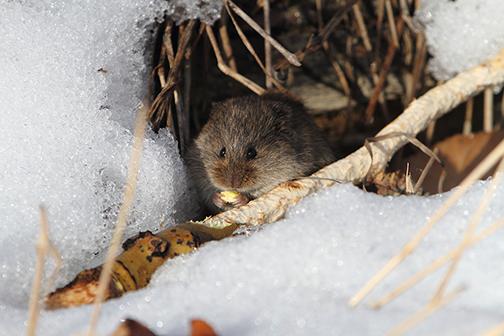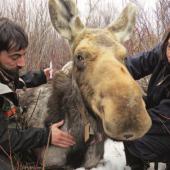Vole Invasion
They're what's for dinner.
Anyone out and about lately has probably noticed a maze of small trails etched into the grass. Our mid-winter thaw reveals these trails, along with nests of grass, and piles of small feces, all signs of vole activity. Perhaps your cat has been bringing them in as a sign of affection, like ours, which let a few live ones loose in the house just to keep things interesting.
Eight species of voles inhabit Montana, including meadow vole, prairie vole, long-tailed vole, and montane vole. Voles are often confused with moles, mice, and gophers, but are different from all three. They have compact bodies, short, inconspicuous ears, stubby naked tails, and relatively small eyes. Voles live in underground burrows, but also take advantage of the sub-nivean (under-snow) habitat to stay active and protected all winter, since they don't hibernate.
Prairie voles (Microtus ochrogaster) are known to mate for life, unlike most rodents which tend to be promiscuous. They share the responsibilities of nest-building and pup-raising, and seem to demonstrate affection through grooming and huddling. They will, however, like many humans, occasionally mate with another partner.
Vole populations are cyclical, with outbreaks occurring every few years. Prolific breeders that can have up to five litters annually, voles give birth to about six young per litter. Of late there seems to be a super-abundance of voles. This comes as a bonus to predators and a bummer to humans. If you're a wintering hawk, a raven, a coyote, an owl, or an ermine, you're having a field day with all the voles everywhere. Lack of snow cover and a lot of ice where there should be snow means voles are exposed, leaving them vulnerable. People, however, may not be so pleased with hordes of voles, since they can be quite destructive.
Fortunately voles rarely live indoors, but they do gnaw on trees and shrubs during the fall and winter, eating away the bark at the base of the plant and potentially killing it. Voles also like to chow down on crops such as potatoes, alfalfa, clover, and sugar beets. These pesky rodents make runways and tunnels throughout lawns and golf courses, damaging the grass and disrupting irrigation.
Montanans can deal with the inevitable presence of voles by wrapping the bases of trees and shrubs in the fall and clearing away leaf litter and other detritus from trees. Mowing lawns short can discourage voles and limit the damage they cause. Solar-powered sonic pest-repellers are a great nontoxic way to keep voles away from your yard and shrubs. You can also trap them, but traps must be checked frequently. Poisoning is a bad idea because it accumulates up the food chain. Predators such as coyotes and foxes are your friends when it comes to vole control.
As you ramble about during this winter, keep an eye out for vole sign, and remember, it’s the little guys that make the world go 'round.














